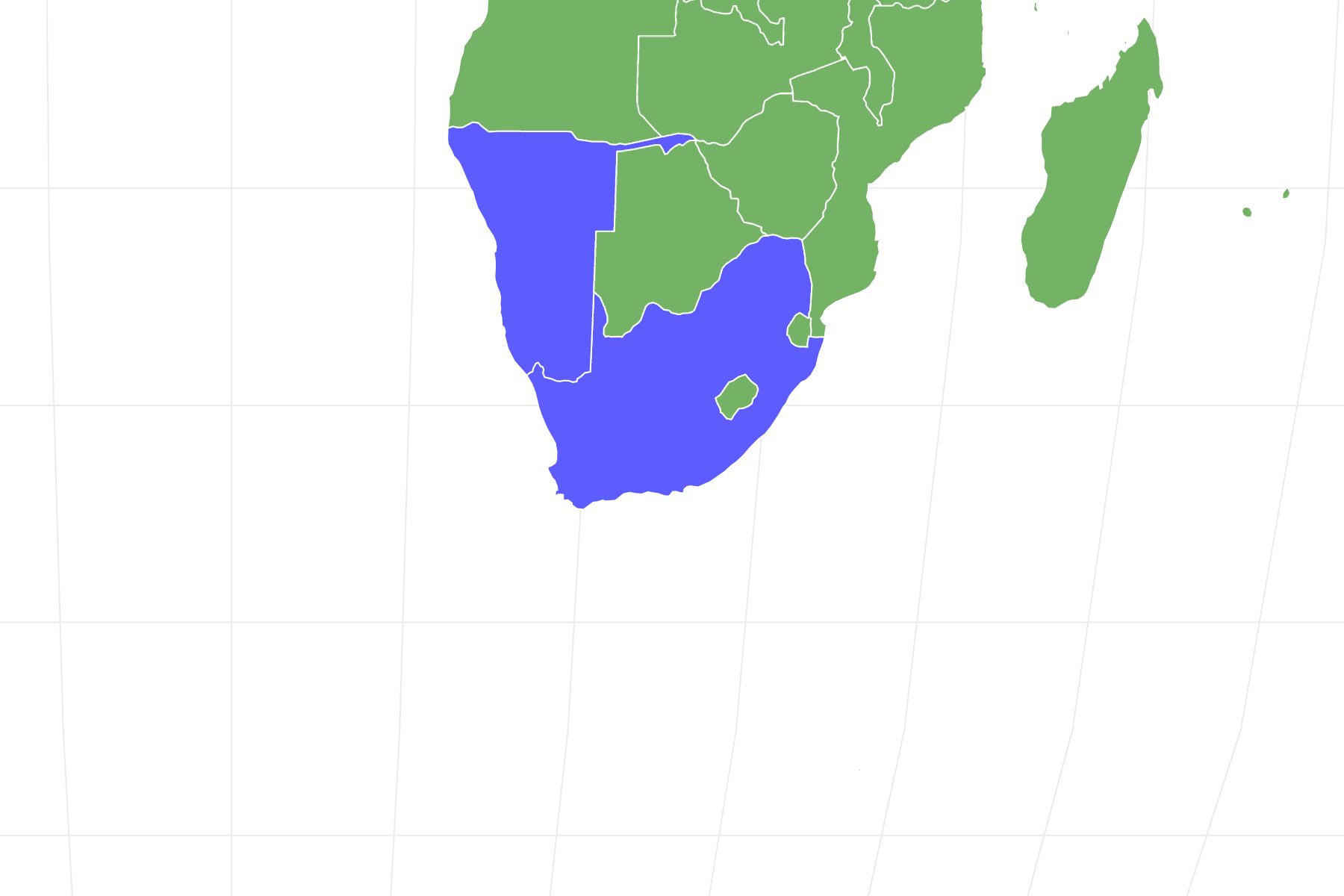African Penguin
Spheniscus demersus
The only penguin species in Africa!
Advertisement
African Penguin Scientific Classification
- Kingdom
- Animalia
- Phylum
- Chordata
- Class
- Aves
- Order
- Sphenisciformes
- Family
- Spheniscidae
- Genus
- Spheniscus
- Scientific Name
- Spheniscus demersus
Read our Complete Guide to Classification of Animals.
African Penguin Conservation Status
African Penguin Facts
- Prey
- Fish, Squid, Crustaceans
- Name Of Young
- Chick
- Group Behavior
- Colony
- Fun Fact
- The only penguin species in Africa!
- Estimated Population Size
- 140,000
- Biggest Threat
- Habitat disruption
- Most Distinctive Feature
- Pink glands above their eyes
- Other Name(s)
- Jackass Penguin
- Incubation Period
- 40 days
- Age Of Fledgling
- 3 - 5 months
- Habitat
- Rocky Ocean Islands
- Predators
- Sharks, Fur Seals, Gulls
- Diet
- Carnivore
- Lifestyle
- Diurnal
- Common Name
- African Penguin
- Number Of Species
- 1
- Location
- south-west African coast
- Average Clutch Size
- 2
- Slogan
- The only penguin species in Africa!
- Group
- Bird
View all of the African Penguin images!
African Penguin Classification
The African Penguin is a small to medium-sized Penguin species that is found along the coast of South Africa and on a number of its surrounding islands. The African Penguin is thought to be most closely related to the Humboldt and Magellanic Penguins found in southern South America, and the Galapagos Penguin found in the Pacific Ocean near the Equator. The African Penguin was named for the fact that it is the only species of Penguin that is found breeding on the African Coast, and it is believed to be one of the first Penguin species to be discovered by humans.
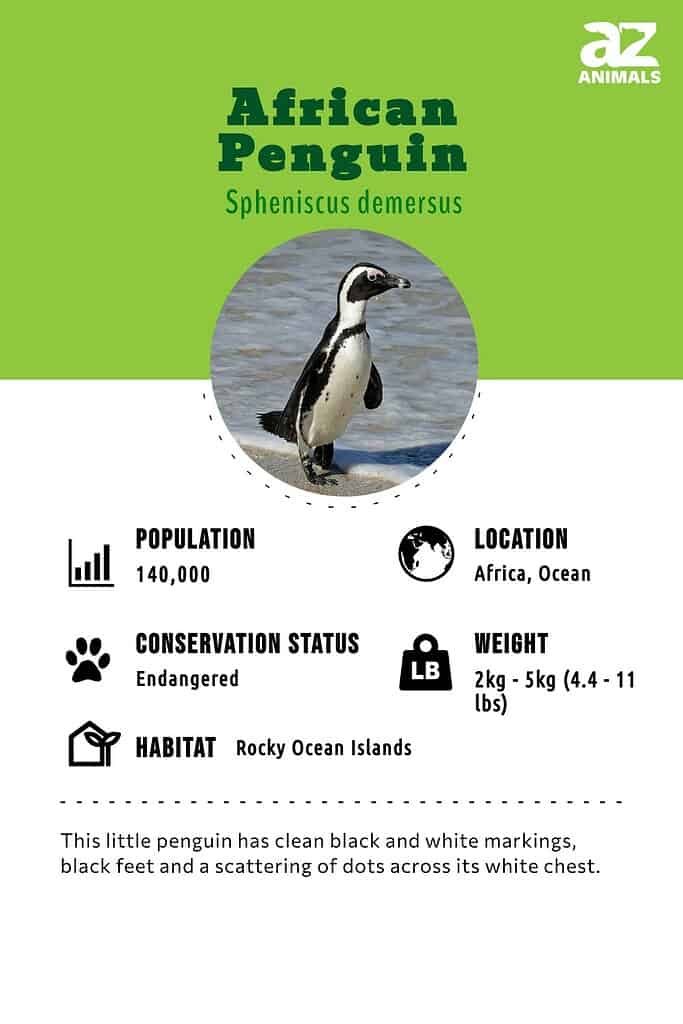
Evolution
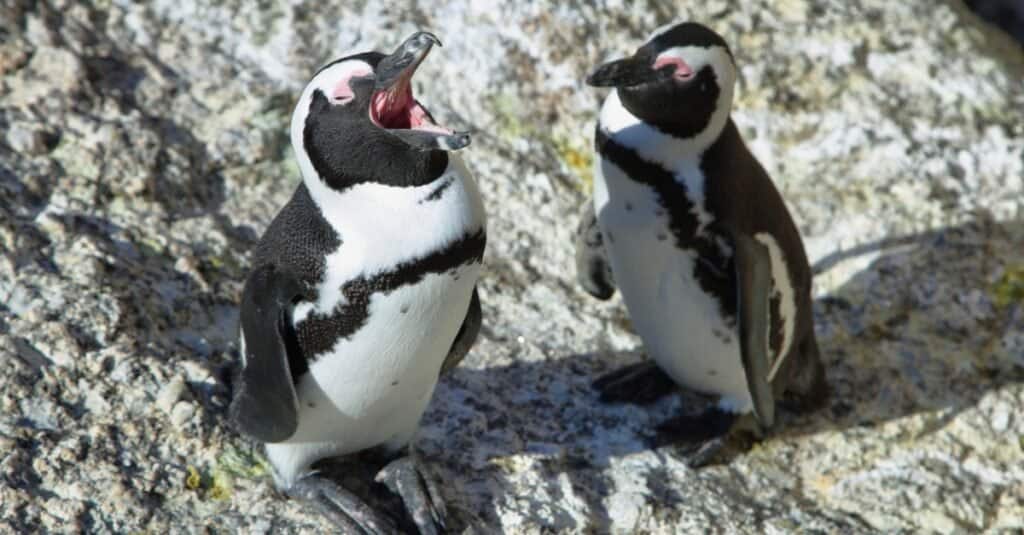
African penguins have only been in Africa for around 300,000 years.
©iStock.com/estivillml
The third time was the charm for the African penguins after repeated attempts to settle the south African coasts. The first group went extinct millions of years ago – then another group made the trip. Those first penguin settlers came to Africa 30 million years after they had first spread to Australia, Antarctica, and South America. The fossil remains of four extinct species other than the black-footed African penguin have been found and dated.
Two of the extinct species, Inguza and Nucleornis, arrived in Africa after the current ocean system was in place – 20 million years ago. The fact that ocean currents didn’t flow toward the continent before being reorganized explains why penguins were late to arrive in Africa and never arrived in Madagascar. The oldest fossils of the black-footed African penguin are around 300,000 years old.
Anatomy and Appearance
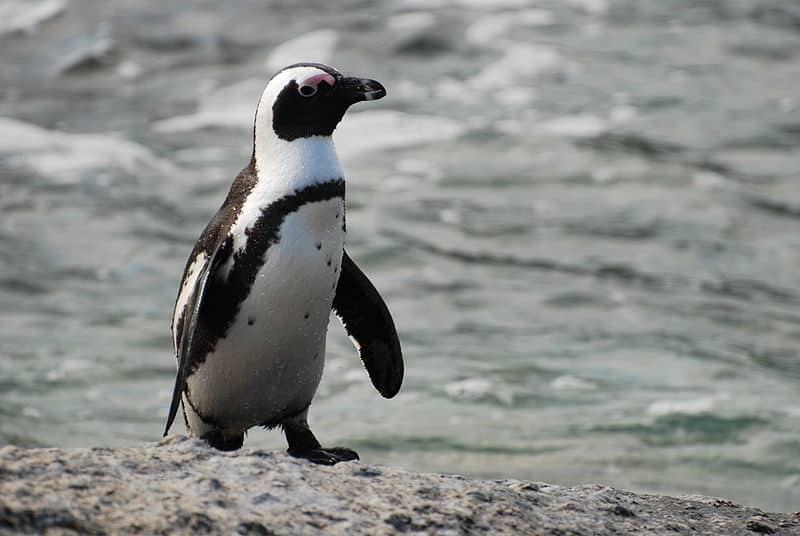
African penguins have pink glands over their eyes to help them to cope with the heat.
©Paul Mannix, CC BY-SA 2.0, via Wikimedia Commons – License
The African Penguin is a fairly distinctive species of a penguin with clean black and white markings and a sharply pointed black beak. The African Penguin also has black feet and a number of dot-like markings flecked across its white chest which are said to be as unique to the individual Penguin as a Human fingerprint is, along with a narrow black band. The male African Penguin is generally slightly larger than their female counterparts but both are fairly similar in appearance. One of the African Penguin’s most distinctive features is that they have pink glands above their eyes which help them to cope with temperate climates. The hotter the African Penguin gets, the more blood is sent to these glands so they may be cooled by the surrounding air, which in turn, makes these glands pinker.
Distribution and Habitat

African penguins nest on rocky islands off the western coast of South Africa.
©Chang Han Chris Kim/Shutterstock.com
The African Penguin is found on the southwestern coast of Africa, living in 27 colonies on 24 islands between Namibia and Algoa Bay, near Port Elizabeth, South Africa, with the largest colony found on Dyer Island, near Kleinbaai. African Penguins are most densely distributed around the cold, nutrient-rich waters of the Benguela Current where there is a plentiful supply of food. Although they spend much of their time at sea, African Penguins gather in nesting sites on rocky islands where they spend their days in sheltered burrows to avoid the hot sun. They are one of the only Penguin species to be found in non-freezing conditions and cope with this by burrowing, emerging at dusk and dawn, and using the pink glands above their eyes to cool the blood down.
Behavior and Lifestyle
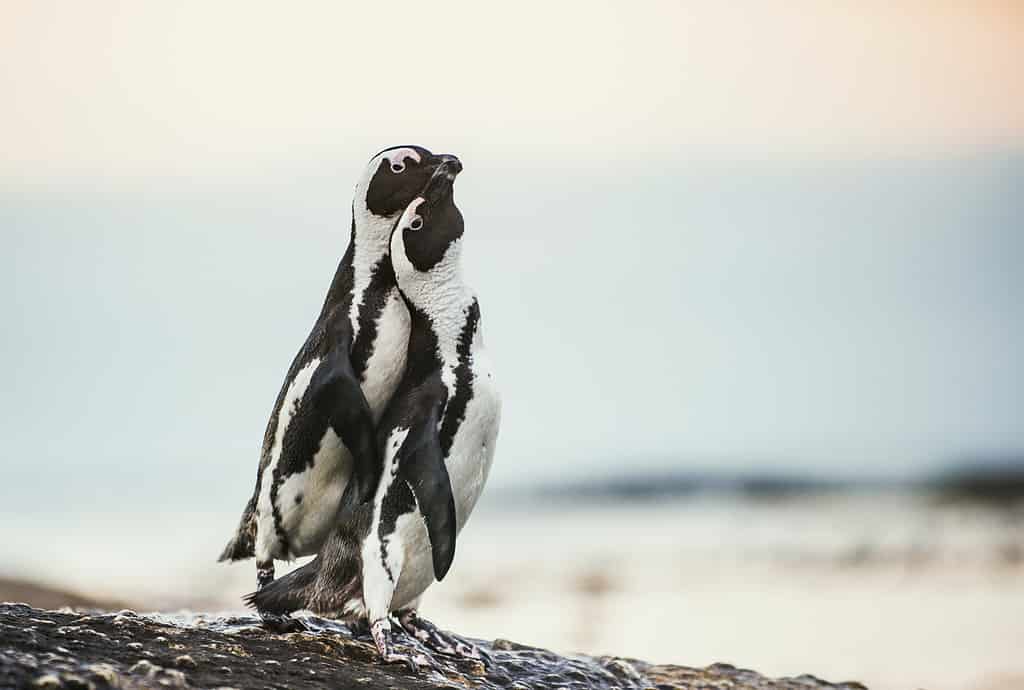
African penguins mate for life and raise their chicks together.
©Sergey Uryadnikov/Shutterstock.com
Like many other Penguin species, African Penguins are incredibly sociable birds, with adults forming pair bonds that last for life (as long as 10 years). African Penguins can often be seen grooming one another, which is not only practical for cleaning purposes, but also for removing parasites and even just rearranging feathers, constantly strengthening the social bond between the pair. Their courtship displays are often very noisy as the male and female Penguin calls to each other using a series of donkey-like sounds. African Penguins are also known to submit to a spot of bathing only a few meters from the shore, which they are thought to do quite regularly to both clean and cool themselves down in the heat.
Reproduction and Life Cycles
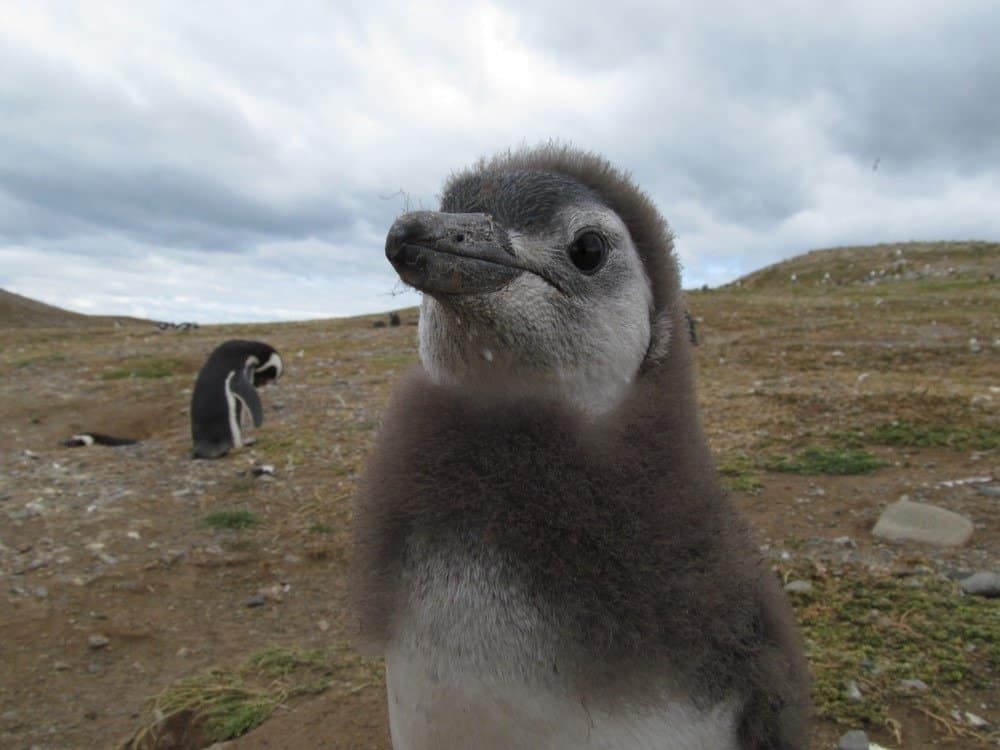
Penguin chicks are reared by both parents.
©Ian Rossi/Shutterstock.com
African Penguins begin to breed at the average age of four when a male and female will pair up and tend to breed together for the rest of their lives. The female African Penguin either digs herself a burrow or finds a dip beneath a rock or bush, in which she lays two eggs. The eggs are incubated by both parents for up to 40 days when only one of the eggs will usually hatch. The African Penguin chicks are fed and kept warm by their parents constantly until they are a month old when they begin to be left on their own, forming crèches with other chicks for protection from predators. They tend to remain with their parents until they are between 3 and 5 months old when they will leave the colony (this is dependent on the supply and quality of food in the area). The chicks return to the colony after a couple of years to molt into their adult plumage. African Penguins generally live for between 10 and 15 years.
Diet and Prey
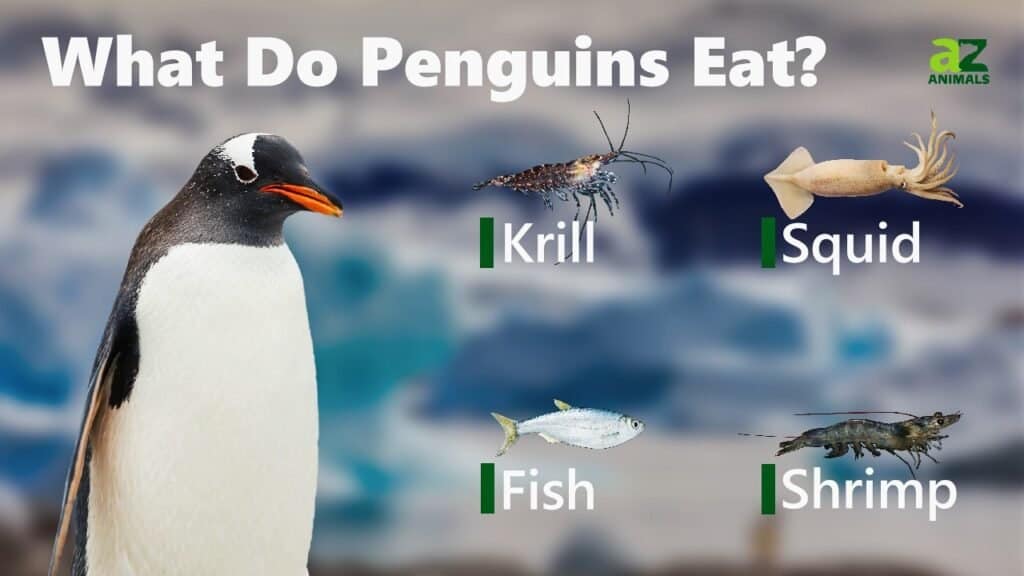
The African Penguin is a carnivore with a diet of fish including Anchovies, Sardines, Horse Mackerel, and Round Herrings. Fish make up the bulk of the African Penguin’s diet, along with the occasional Squid or Crustacean when normal food is in short supply. The streamlined body of the African Penguin allows it to move through the water like a rocket, capable of reaching a top speed of around 20 kph when hunting for food. African Penguins catch their prey by diving into the ocean depths for around 2 minutes at a time. Although they normally go to depths of around 30 meters, it is not uncommon for them to be found hunting more than 100 meters beneath the water’s surface.
Predators and Threats
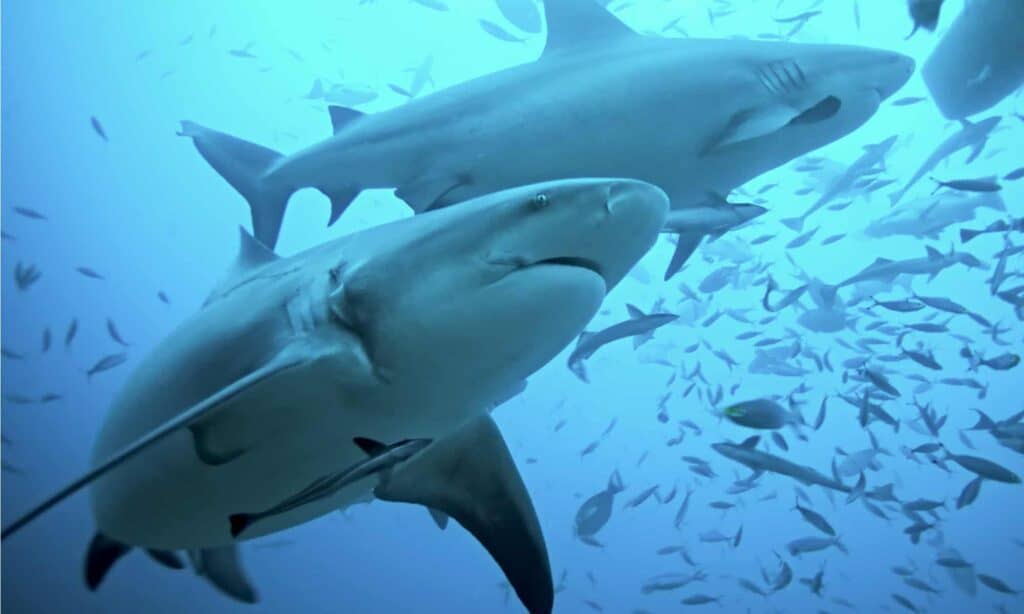
Sharks prey on African penguins.
©Martin Prochazkacz/Shutterstock.com
The African Penguin’s smaller size means that it has many predators both in the water and also on dry land. Their marine predators are primarily Sharks and Cape Fur Seals, but the biggest threat to them on land is not just to the adult Penguins, but more to the vulnerable eggs and chicks. Kelp Gulls and Scared Ibises prey on them from the air and Mongooses, Snakes, and Leopards have been observed hunting them on the ground. The African Penguin has also been severely affected by Human activity in their native regions, with populations thought to have taken a drastic decline, mainly due to the exploitation of their eggs for food when they were first discovered. They are also severely affected by the disruption of their natural habitats.
Interesting Facts and Features

Penguins have more feathers than any other bird, acting as a waterproof layer to keep their skin dry.
©Mike Korostelev/Shutterstock.com
Penguins have more feathers than any other bird, which act as a waterproof layer keeping their skin dry. African Penguins molt once a year which they do back in their colonies. The whole process lasts for about 20 days, in which time, the African Penguins cannot swim or eat, and can lose almost half of their body weight. African Penguins are known to spend long periods of time fishing out at sea, and depending on the area, can travel between 30 and 110 km in one trip. However, those African Penguins who have chicks to feed will rarely go that far, catching food closer to the shore, and as quickly as possible.
For more interesting facts, read ”10 Incredible African Penguin Facts.“
Relationship with Humans
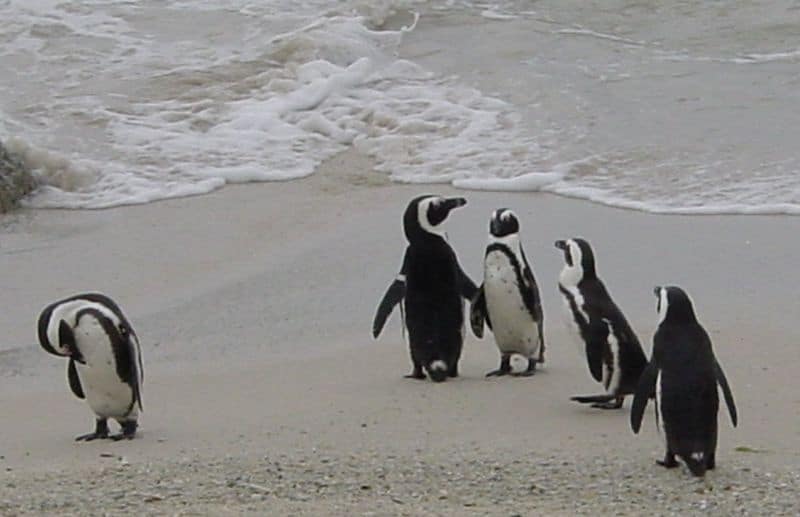
African penguins were the first penguin species to come in contact with humans.
©tato grasso, CC BY-SA 2.5, via Wikimedia Commons – License
It is widely believed that African Penguins were one of the first Penguin species to come into contact with humans, due to the fact that they are found on the temperate South African coast rather than in the heart of Antarctica. This however, does not seem to have worked to the bird’s advantage as their eggs were stolen for food (slowing the rate of reproduction), and the guano used in nest building was harvested for fertilizer. Today, other threats face the African Penguin including competition for food from commercial fishing and oil pollution in the water. Only a small handful of nesting sites can be accessed by tourists, but the Penguin’s nervous nature of people means that these areas have to be strictly monitored.
Conservation Status and Life Today
Today, the African Penguin is considered to be a vulnerable animal and has been listed as Endangered by the IUCN. It is thought that today’s African Penguin population of approximately 22,000 breeding pairs, is less than 10% of the population that existed in 1900. By the 1950s, the African Penguin population had halved, and it had then halved again by 1980. There is an approximate 2% decline in the African Penguin population every year, mainly due to the human consumption of their eggs, competition for food, and habitat disruption.
African Penguin FAQs (Frequently Asked Questions)
Are African Penguins herbivores, carnivores, or omnivores?
African Penguins are Carnivores, meaning they eat other animals.
What Kingdom do African Penguins belong to?
African Penguins belong to the Kingdom Animalia.
What phylum to African Penguins belong to?
African Penguins belong to the phylum Chordata.
What family do African Penguins belong to?
African Penguins belong to the family Spheniscidae.
What order do African Penguins belong to?
African Penguins belong to the order Sphenisciformes.
What type of covering do African Penguins have?
African Penguins are covered in Feathers.
What genus do African Penguins belong to?
African Penguins belong to the genus Spheniscus.
Where do African Penguins live?
African Penguins live on the southwestern African coast.
In what type of habitat do African Penguins live?
African Penguins live on rocky ocean islands.
What are some predators of African Penguins?
Predators of African Penguins include sharks, fur seals, and gulls.
How many eggs do African Penguins lay?
African Penguins typically lay 2 eggs.
What is an interesting fact about African Penguins?
The African Penguins is the only penguin species in Africa!
What is the scientific name for the African Penguin?
The scientific name for the African Penguin is Spheniscus demersus.
What is the lifespan of an African Penguin?
African Penguins can live for 10 to 15 years.
How many species of African Penguin are there?
There is 1 species of African Penguin.
What is the biggest threat to the African Penguin?
The biggest threat to the African Penguin is habitat disruption.
What is another name for the African Penguin?
The African Penguin is also called the jackass penguin.
How many African Penguins are left in the world?
There are 140,000 African Penguins left in the world.
How fast is an African Penguin?
An African Penguin can travel at speeds of up to 12.4 miles per hour.
How do African Penguins have babies?
African Penguins lay eggs.
How to say African Penguin in ...
Thank you for reading! Have some feedback for us? Contact the AZ Animals editorial team.
Sources
- David Burnie, Dorling Kindersley (2011) Animal, The Definitive Visual Guide To The World's Wildlife
- Tom Jackson, Lorenz Books (2007) The World Encyclopedia Of Animals
- David Burnie, Kingfisher (2011) The Kingfisher Animal Encyclopedia
- Richard Mackay, University of California Press (2009) The Atlas Of Endangered Species
- David Burnie, Dorling Kindersley (2008) Illustrated Encyclopedia Of Animals
- Dorling Kindersley (2006) Dorling Kindersley Encyclopedia Of Animals
- Christopher Perrins, Oxford University Press (2009) The Encyclopedia Of Birds
- African Penguin Information, Available here: http://www.penguins.cl/african-penguins.htm
- African Penguin Breeding, Available here: http://www.neaq.org/animals_and_exhibits/animals/african_penguin/index.php
- African Penguin Appearance, Available here: http://www.enchantedlearning.com/subjects/birds/printouts/Jackasspenguin.shtml
- African Penguin Behaviour, Available here: http://www.antarcticconnection.com/antarctic/wildlife/penguins/african.shtml
- About African Penguins, Available here: http://www.penguinworld.com/types/african.html

